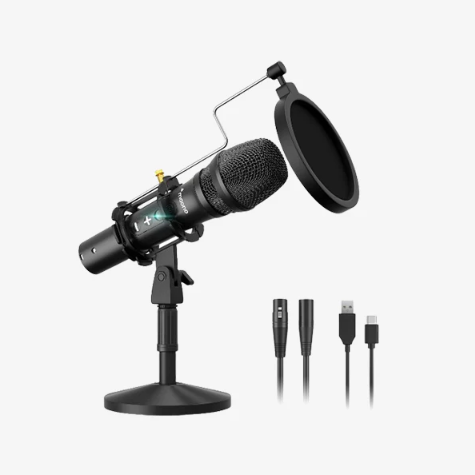In the realm of audio recording and content creation, a USB condenser microphone stands out as a versatile and user-friendly tool, offering professional-grade sound quality without the need for complex setups. This guide explores the features, benefits, and considerations of USB condenser microphones, highlighting their impact on podcasting, streaming, voiceovers, and more.
The Advantages of USB Condenser Microphones:
Plug-and-Play Convenience:
Advantage: usb condenser mic are plug-and-play devices, eliminating the need for additional audio interfaces or complex setups. Simply connect to a USB port, and you're ready to record.
Professional Sound Quality:
Advantage: Known for their superior sound quality, USB condenser microphones capture detailed audio with a broad frequency response, making them ideal for vocals, instruments, and various audio recording applications.
Versatility for Various Applications:
Advantage: USB condenser microphones are versatile tools suitable for podcasting, streaming, voiceovers, music recording, video conferencing, and more. They adapt seamlessly to diverse content creation needs.
Built-In Features:
Advantage: Many USB condenser microphones come with built-in features such as headphone jacks, volume controls, mute buttons, and adjustable gain, providing users with enhanced control over their audio recording experience.
Budget-Friendly Options:
Advantage: USB condenser microphones offer cost-effective solutions for those seeking professional audio quality without investing in expensive studio setups. They provide an affordable entry point for content creators.
Considerations When Choosing a USB Condenser Microphone:
Frequency Response:
Consideration: Assess the microphone's frequency response to ensure it aligns with your recording needs. Different frequency ranges suit various applications, from vocals to musical instruments.
Polar Pattern:
Consideration: Polar patterns, such as cardioid or omnidirectional, determine the microphone's sensitivity to sound from different directions. Choose a pattern that suits your recording environment and minimizes background noise.
Bit Depth and Sample Rate:
Consideration: Higher bit depths and sample rates contribute to better audio quality. Consider your specific recording requirements and choose a microphone that meets those standards.
Build Quality and Durability:
Consideration: Assess the build quality of the microphone, including materials used and overall durability. This is especially important for users who may be moving or transporting the microphone frequently.
Additional Features:
Consideration: Evaluate additional features, such as headphone monitoring, volume controls, and mute buttons. These can enhance your recording experience and offer more flexibility in various scenarios.
Notable USB Condenser Microphones:
Blue Yeti:
Features: Multi-pattern (cardioid, bidirectional, omnidirectional, stereo), adjustable gain control, headphone monitoring, and a mute button.
Audio-Technica ATR2500x-USB:
Features: Cardioid polar pattern, 24-bit/192kHz audio resolution, headphone jack with volume control, and a sturdy build.
Rode NT-USB:
Features: Cardioid polar pattern, studio-quality recording (24-bit/48kHz), integrated pop shield, and direct monitoring.
Setting Up and Using a USB Condenser Microphone:
Connect to USB Port:
Plug the USB condenser microphone directly into an available USB port on your computer or compatible device.
Adjust Settings:
Use the microphone's built-in controls or adjust settings through your computer's audio settings to optimize gain, volume, and monitor levels.
Select Recording Software:
Choose a recording software or digital audio workstation (DAW) to capture and edit your audio. Most USB condenser microphones are compatible with popular recording software.
Test and Monitor:
Conduct a test recording to ensure proper setup. Use the microphone's headphone monitoring feature, if available, to monitor your audio in real-time.
Positioning and Environment:
Experiment with microphone positioning and consider your recording environment. Minimize background noise and use pop filters if necessary for clear and professional results.
Conclusion:
A USB condenser microphone is a game-changer for content creators, podcasters, musicians, and anyone seeking high-quality audio recording with simplicity and affordability. With their plug-and-play convenience and professional-grade features, these microphones empower users to elevate their audio content and express their creativity with crystal-clear sound. Choose the right USB condenser microphone based on your specific needs, and embark on a journey of immersive and professional audio recording.
For more info. Visit us:
